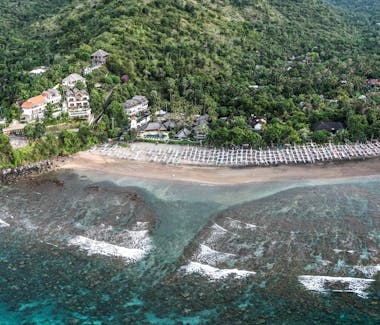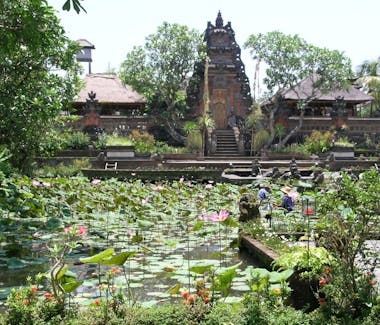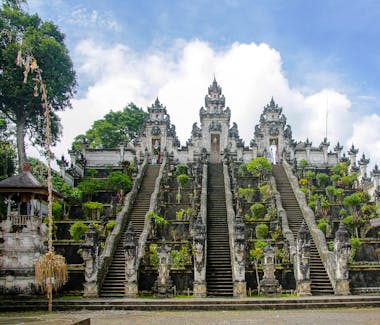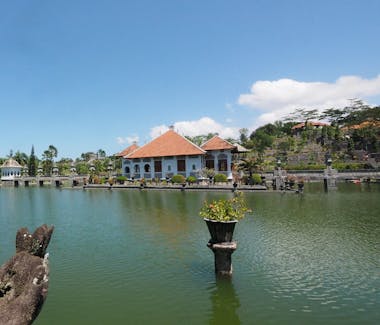Attractions











Palm Garden - Amed - Tulamben
Diving and Snorkelling
During your stay with us, you should take advantage of the well-known dive schools (PADI certified) in the immediate vicinity of our Resort, offering scuba diving courses and trips to marvellous coral reefs and fascinating underwater places. Many of the dive schools offer multilingual service and are just a few minutes away by boat or car.
- Liberty Wreck in Tulamben
- Japanese Wreck
- Coral Garden in Jemeluk
- Gili Selang
- Manta Spot at Nusa Penida
At Palm Garden Amed Resort & Spa, we are blessed with coral reefs directly in front of our property, where you can experience some unforgettable snorkelling adventures.


The Gili Islands
Fast Boat to the Gili Islands
Crossing the Lombok Strait from Padang Bai to the Gili Islands takes 1.5-hours, making this the shortest and fastest route. A number of fast boat companies operate from Padang Bai, and there are several crossings per day.



Tours
Tours
Special unique and tailor made tours only by PALM GARDEN AMED RESORT
- Seraya Tour (traditional weaving - Water Palace - Silver jewellery processing .... )
- Ikat Tour (Snake fruit plantation - Sidemen traditional Ikat weaving - painting at judgment hall .... )
- Ubud-Tour (Volcano lakes - market - coffee luwak - tempel and rice terraces - Ubud shopping, dancing ....)
Enjoy an up-close and personal experience of Bali. PALM GARDEN AMED RESORT is an ideal base from which to take day-trips and half-day-trips to witness Bali’s authentic culture and history first-hand.
Choose from a wide variety of activities including:
- Cultural Trips, Temple Visits, Balinese-Hindu Ceremonies
- Hiking in the rice fields, Trekking, Cycling
- Bali Zoo, Elephant Safari Park, Bird Park


Ubud
Ubud
The inland town of Ubud (77km from Palm Garden Amed) has long been recognised as Bali’s cultural hub, home to a small treasure trove of art museums and galleries, featuring traditional and modern artwork including paintings, ceramics, carvings, sculpture, batik, weaving and photography. It is also the seat of the Sukawati Royal Family; the palace is centrally located and open to the public. In the neighbouring villages, you can watch the island’s most accomplished painters, stonemasons, woodcarvers, mask makers and silversmiths at work. Ubud is a great place for traditional balinese dancing at the temples in the evening and also for shopping: classic, contemporary and abstract paintings, plus a massive range of crafts including gold and silver jewellery, woodcarvings, fabrics, clothing, pottery, batik, paintings, metalwork and antiques can all be found in the town’s numerous galleries and shops. The market sells handicrafts, garments, spices and foods, and Ubud even has its own sacred Monkey Forest. The town is surrounded by most of the attributes that entice people to this exceptionally beautiful island: traditional art and craft communities, ancient temples, palaces, emerald rice terraces, vertical river gorges, coconut palms and lush jungle.


Lempuyang
Pura Lempuyang
In the 1960s, before electricity reached Bali, a space satellite reported the observation of a blue beam emanating from Earth; the precise location was plotted and the source was confirmed as the directional temple of Pura Lempuyang Luhur, which is one of Bali’s oldest and most highly regarded temples. The main temple rests on top of the Belibis Hill, northeast of Mount Agung. At 1,175m above sea level, it is reachable via a stairway of 1700 steps, which wind through the forest with attractions along the way including other temples and hordes of grey long-tailed macaques that inhabit the surrounding cool mountain forests. The intense spiritual energy of this place is extraordinary. The temple is located 13km or 30 minutes’ drive from Palm Garden Amed Resort.
Seraya


Tirta Gangga
Tirta Gangga Water Garden
The complex of bathing pools known as Tirta Gangga (21 kilometres or 45 minutes’ drive from Palm Garden Amed Resort), was built by the water-loving Anak Agung Anglurah, the last Raja of Karangasem, who also built the grand water palace of Taman Ujung. Tirta Gangga means ‘Water of the Ganges’ and this exotic, holy water temple rests on the site of a sacred spring emerging from under a banyan tree on the slopes leading up to Mount Agung. The fabled maze of spine-tinglingy cold water pools and basins, spouts, tiered pagoda fountains, moss encrusted statues, stone carvings and lush gardens, is a serene and mellow place, showcasing a blend of Chinese and Balinese architectural styles. The neighbouring rice terrace scenery is nothing less than spectacular.


Lake Batur
Mount Batur Trek
At about 4 am trekking start with guide from the Pura Jati lake Batur.
After an hour you reach a hut where a longer rest is turned on. The reason is that it is sensitive to cold on the summit, and that on top of the crater does not have to wait too long.
The further ascent to the summit is quite sandy and difficult going forward. At about half past five clock reach the lookout.
At about 6.30 am, you can enjoy the beautiful sunrise.
During the descent, one or two stops, inserted in a crater of an active heat source (sulfur).
To about 8 am to reach the starting point goes back to the hotel.
Arrival at the hotel at around 11 am.



Ujung
Taman Ujung Water Palace
The promise of floating pavilions, lotus ponds, fluted columns, intricately carved balustrades, and gateways leading to nowhere, will lure you to the grand water palace of Taman Ujung (26km from Palm Garden Amed). This intriguing, romantic complex of pools is linked by bridges, archways, and a shaded avenue of mango and frangipani trees.
Gunung Agung
Mt Agung Sunrise Trek
At 3014 metres high, Gunung (Mt) Agung is Bali’s tallest and holiest mountain, its resplendent summit dominating much of the island. It is not surprising, therefore, that it is the dwelling place of the gods, with Pura Besakih, the island’s largest and most important Hindu temple, located on its slopes. During the dry season, physically fit hikers can trek up to the top in 3 – 6 hours depending upon the start point.

Besakih
Pura Besakih
As the sun rises from behind the mighty Mt Agung, the misty lower slopes of the volcano buzz with vibrant activity. Within a myriad of thatched pagoda roofs above quilted terraces of rice, hundreds of devout Balinese Hindus in ceremonial dress solemnly ascend a giant stairway to pay homage to the gods. The air is thick with the scent of burning incense and the sound of the gamelan, as the white clad priests symbolically sever their connection with the everyday world and invite the gods to “come down and join us”. Outside the confines of the temple complex is a plethora of souvenir and food stalls where hawkers and guides ‘Guardians of the Temple’ are preparing for the daily influx of visitors. Known as the Mother Temple, Pura Besakih is Bali’s largest and most important temple complex, comprising at least 86 temples that include the main Pura Penataran Agung (the Great Temple of State) and 18 others situated on the slopes of the holy mountain and surrounded by breathtaking scenery.
